Back in 2017, Sheldon Stopsack explained in detail the work of MPC on Transformers: The Last Knight. He then worked on Roma and joined the Weta Digital teams in 2018. He worked on Gemini Man and Terminator: Dark Fate.
Carmelo Leggiero has been working at Weta Digital since 2010. He has worked on many of the studio’s projects such as Prometheus, The Jungle Book, War for the Planet of the Apes and Rampage.
How did you and Weta Digital get involved on this show?
Sheldon Stopsack // We got involved early in the pre-production phase. One day the script for what was then called Ghostdraft landed on my desk. Filmmakers were actively working on the creature design and had created some amazing artwork. Visualising a beautiful creature design is one thing, but it is something different to see that design come to life. We straight away engaged with the pitch, partly to express our desire to join the show and also to help the filmmakers with the process of finding our creature. We gathered a small group of highly talented artists across all domains and pulled together some amazing development. Our number one rule was to think outside the box as we explored the uniqueness of the white spike. The result must have been convincing enough for our team at Weta Digital to become the lead vendor for the creature work.
How was the collaboration with director Chris McKay and Overall VFX Supervisor James E. Price?
Sheldon Stopsack // The short answer is ‘fantastic’. I hadn’t met Jamie or Chris beforehand, but our communication was great right from the start. Throughout the project, we established a relationship of mutual trust that carried on all the way to the end. It was a very pleasant experience, and I think that was reflected by the team here at Weta who were willing and keen to give the project their all.
What were their expectations and approach about the visual effects?
Sheldon Stopsack // We needed to be agile and keep ahead of the game—just as we had with our pitch. I wanted to continue bringing something to the table before we were asked. Jamie, Chris and I operated on a very similar wavelength, which worked in our favour, as we were usually already focusing our efforts in the right direction. It was a fortunate circumstance as it simply came down to having similar taste and vision. That being said, Chris is a restless character, which I mean that in the nicest way possible! He was always on the lookout for something new, so it was a matter of finding a new idea that hadn’t been explored yet. Chris didn’t want to risk missing out on an opportunity that may be hidden within a sequence.
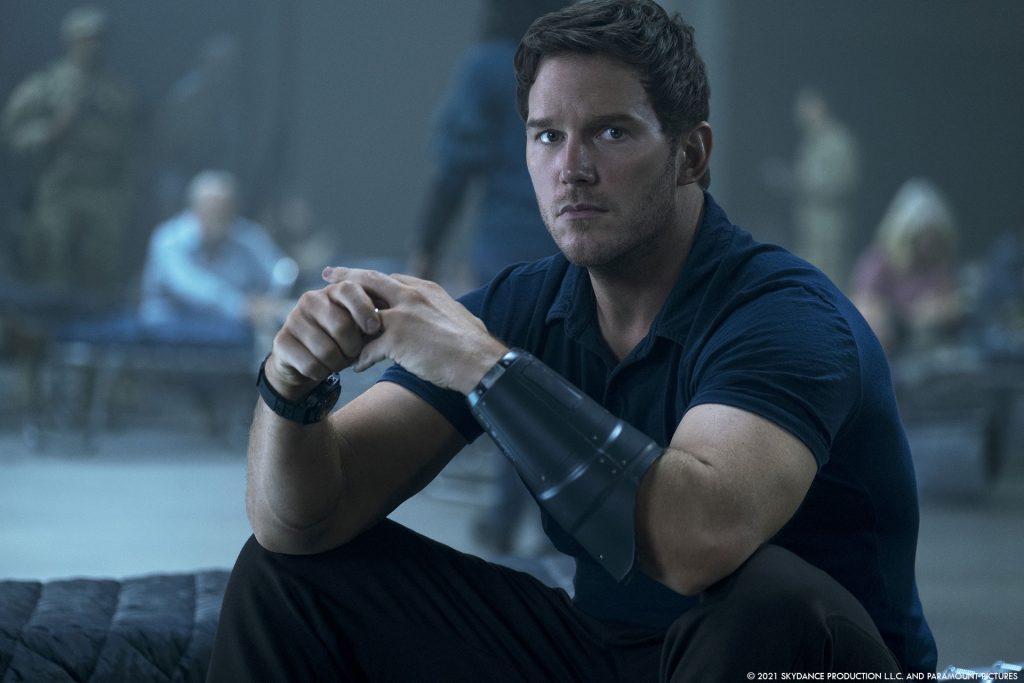
How did you organize the work with your VFX Producer?
Sheldon Stopsack // Ben Pickering produced “The Tomorrow War” here at Weta Digital. We had worked together before alongside Production Manager Hugo Morris. This was beneficial as we got straight back into the groove of things. We decided to split the body of work across two teams, Team Fire and Team Ice, based on the workload and type of work. Looking at the content we produced, it’s not hard to guess which portion went to which team. It’s always tricky to split a body of work like that, as you want to keep things well balanced between the two. Each team had their challenges, so I have to give credit to our Compositing Supervisors, Simon Jung and Ben Warner, and our CG Supervisors, Ben Campbell and Mark McNichol. Everyone pushed things forward massively and never made it feel like there was a disconnect between the teams.
What are the sequences made by Weta Digital?
Sheldon Stopsack // Our first sequence is set in the future at Deepswell—an offshore complex of former oil rigs that form the last standing outpost and research facility of humankind. We took care of this environment from start to finish, from the establishing shots, which showed the entire build in its full glory, to Dan and Muri in the research lab testing on the captured female white spike. Our most formidable shots are the white spikes attacking Deepswell in huge swarms, causing significant damage and destruction as the army fight them off. Our FX team kept busy creating structural effects combined with volumetric explosions, pairing these with ocean water simulations, and populating the scene with large numbers of Crowd, MotionEdit or hero animation creatures.
“White Spike on Ice” was the final act of the movie, set in a glacier environment where Dan and James face the hero female white spike in a standoff. The sequence was shot on a live location in Iceland and supplemented with additional shots filmed on a bluescreen stage back in the US. We built the entire environment as a digital set to accommodate full CG shots.
The sequence features a large number of shots, all filmed in various settings with different weather and lighting conditions. The key was to integrate them so they appeared to be filmed in a singular location. Chris also had the idea to use the weather almost as its own character, so depending on where we were in the sequence, we would either see a beautiful vast landscape or be engulfed in a raging snowstorm. Managing these conditions across shots and our artists was tricky, so we opted for a back-end solution. We orchestrated the majority of volumetric effects like rolling snow gusts and clouds in comp. Angelo Perrotta, one of our comp leads, took the initiative and developed a comp-based solution utilising our extensive library of VDB brick maps, which were used to create a shot-based weather condition. It allowed us to stay flexible throughout the pipeline by guaranteeing continuity and allowing us to react to clients notes without having to backpedal through the FX process to make changes.
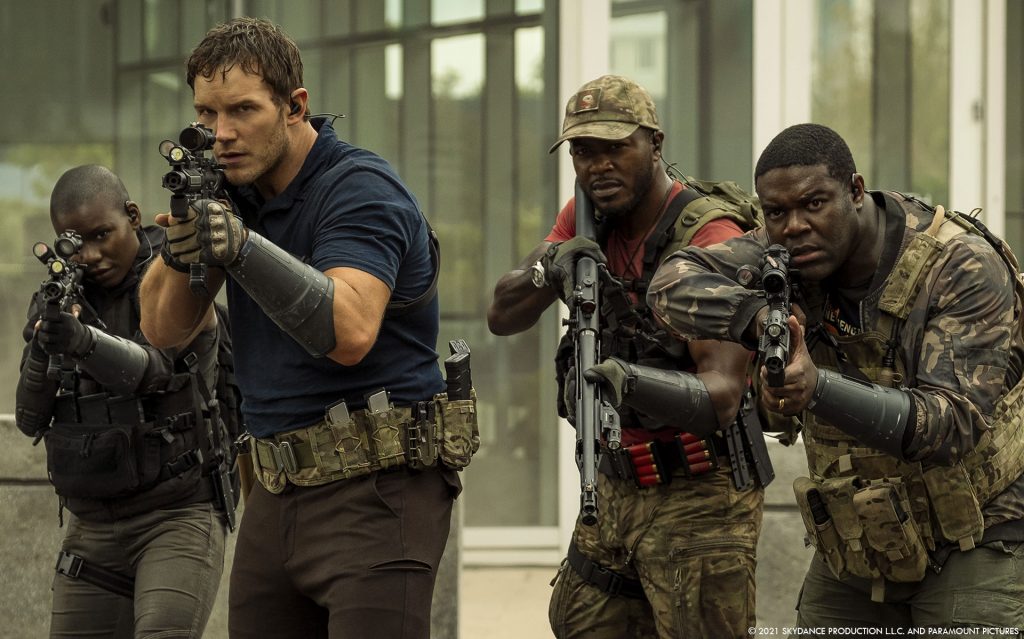
How did you work with the art department for the terrifying creature, the white spike?
Sheldon Stopsack // As we started our journey to develop the white spikes, we were already well into a couple of rounds of artwork. A number of artists were involved in that process, including Weta’s own art department. It gave us a great starting point as it laid out a foundation to build on top of. The basic idea of the white spike design was established, but the trick is always to translate the art into something that comes to life.
Can you explain in detail about their creation and especially the female?
Sheldon Stopsack // Our mantra when designing the white spikes was “leave no stone unturned”. That held true for pretty much every department involved in the process of discovering the creature. Instead of looking at this task mechanically, we hypothesized its characteristics and capabilities and considered how they would influence their appearance. We described them as intelligent, able to coordinate as groups, yet relentless and self-sacrificing. Those things quickly led to the question, how do they communicate? Vocal or non-vocal? If not vocal, what can be done with haptics? What other things are there that we hadn’t considered using in the past? It was a fun exercise as it always seemed to open a new door that we hadn’t thought about. We spent a decent amount of time creating motion studies that were carried all the way through the pipeline. Along the way, we always found something new.
How did you create their skins and eyes?
Sheldon Stopsack // Early during our pitch work, we explored a wide range of skin textures. We wanted to break boundaries, so we looked at unusual references like plastination and mummification, as well as typical zoological skin. Chris often described the white spikes as necrotic, so we knew we needed to find a recipe that combined several attributes. Two aspects became critical for us in the development— kin flakes and the use of internal geometry contributing to the surface shading. Both were explored during the pitch by Milton Ramirez and Mathias Larserud. To get the right look, we ended up duplicating two layers of skin. The first layer had metallic-like shading to create an inwards displacement effect which we blanketed with a second highly translucent outer layer resulting in a ghostly look. Then we duplicated this double-layer to create a layer of flakes, displacing it to mimic a sense of skin peeling off in irregular patterns. Chris pushed this idea to the limit, to the point where we started to feel borderline uncomfortable.
As you may have guessed by now, we seeded many ideas in the early days, and the eyes were no exception. We worked on a motion vignette during the pitch where a white spike was munching on a bone with meat on it. The shot was set up as a first-person view with a directional torch light. As the camera tilts up to meet the white spike’s face, the torch triggered a cat-eye like retroreflection. We and the filmmakers fell in love with the idea, so it was only logical to integrate this feature into the hero film asset. Technically it was achieved by a second recessed membrane inside the eye that had a view-dependent response to light. We knew it responded to the direct torch light, but I was surprised at the number of times we got a strong response from our default shot lighting. It became a feature that just worked as opposed to us having to cheat it.
Can you tell us more about the rigging and animation work?
Carmelo Leggiero // The white spike rig was challenging due to the creatures having multiple limbs and tentacles. It was in constant development throughout the production as we continued to evolve the white spikes’ capabilities and motion. Craig Penn and Florent Limouzin did a lot of the animation groundwork by stress-testing new features on the rig to make sure our Animators could deal with any possible scenario. We build anatomically correct creatures with bones and muscles under the hood that keep us grounded in reality. It restrains (in a good way) our animation in favour of maintaining the creature’s correct physiology.
White spikes are very torso heavy—their backs are solid armour and almost bulletproof. So our approach to rigging the torso was to minimize any possible movement that would inevitably make it feel vulnerable.
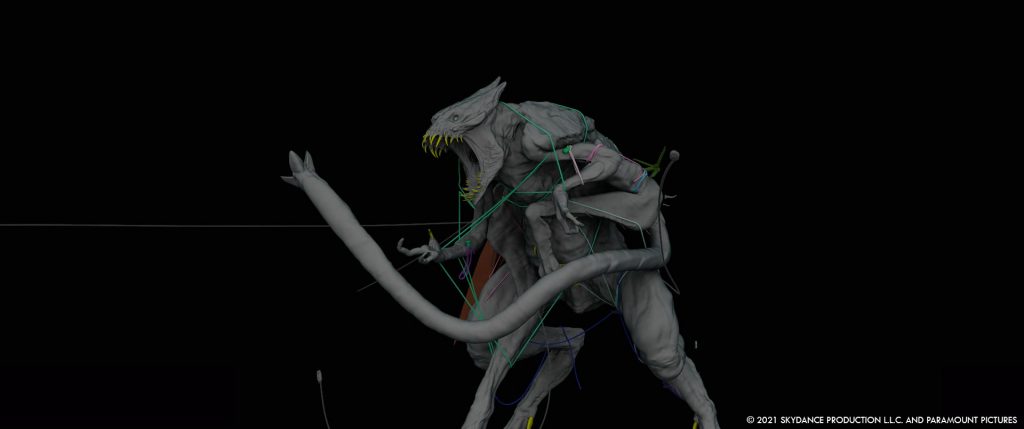
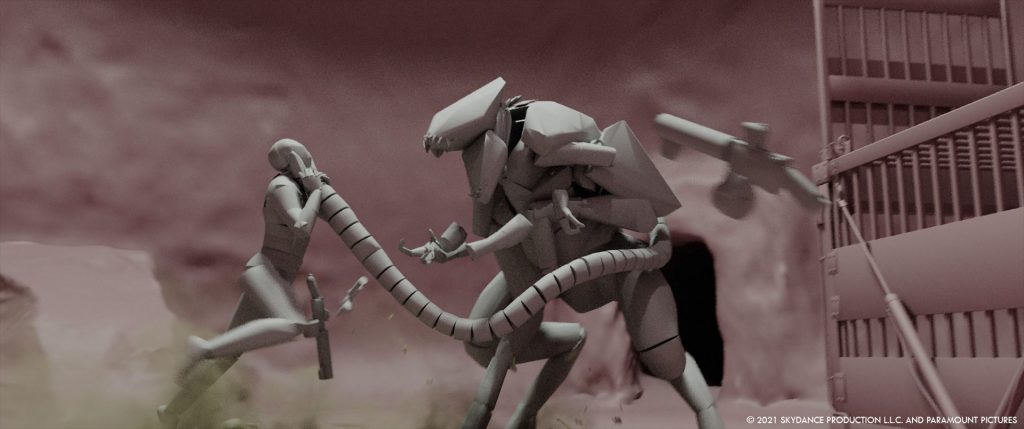
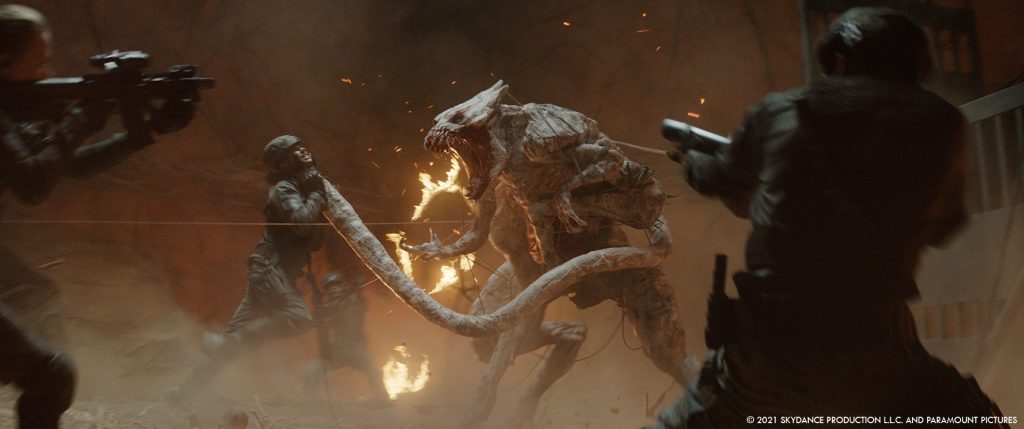
How do their many legs and tentacles affect your work?
Carmelo Leggiero // With a creature like this, it’s always a learning curve. Being on the show from the very beginning meant I was able to experiment and try different things.
The white spike design references a melting pot of animals. The walk cycle is based on a bear in terms of patterns and timing, but the front legs and scapula behave very much like a feline. This created a nice contrast. Instantly by looking at them walking, you could feel their power, stealthiness and agility. They can jump and twist in mid-air like cats to prepare for landing, crawl on walls like spiders, swim efficiently like dolphins, and even glide like squirrels.
The tentacles were almost a whole new creature. From the early tests, we agreed they should appear to have a mind of their own and move independently of the direction and motion of the main body. This created another element of aggression by making the white spikes very hard to surprise and shoot spikes from multiple angles. When attacking and firing, tentacle animation and behaviour imitates snakes. When the white spikes run, tentacles act as tails, providing a counterbalance for sharp turns, or as an extra limb for leverage or support.
Did you receive specific indications and references for the animation?
Carmelo Leggiero // We all wanted to make the creatures as unique as possible, so there was a constant exchange of ideas with the client-side VFX Supervisor James E. Price and Director Chris McKay. We also explored ideas extensively within the team—each day, someone would come to work and share some awesome references they’d found online. Nothing was too bizarre as long as it came from an actual living animal—and we did find some really strange things :). We always went into the animal kingdom for inspiration instead of other creatures or monsters seen in other movies. The Director had a motto that stuck with me for the duration of the project “Keep white spikes weird, Keep white spikes real.”
How did you manage the crowd work for the aliens?
Carmelo Leggiero // The Crowds work was a great collaboration with our Crowds and Motion Edit team. Knowing the number of white spikes we had to deal with in a few sequences, we came up with a strategy that would make things a little easier. Some shots featured swarms of over 10000! Our Animation department created all sorts of cycles: walking, running, jumping, dying, swimming, climbing, vocalization, diving, attacking, flying…I could go on and on!
For shots where numbers weren’t too big—maybe 50 to 300 creatures—we handed over cycles to the Motion Edit department, who put together combinations to create much more complex motion over intricate terrain. These were essentially hero actions on a larger scale. Our Crowds department also had access to these cycles, and they would come in to play in shots where the number of creatures was insane. You can see a lot of their work in the Deepswell battle. It wouldn’t have been possible to do this complex work without the Motion Edit and Crowd team.
How was it to simulate their presence on-set for the cast and for the framing?
Carmelo Leggiero // For some crucial scenes, like Capturing the Female, a stuntie would interact with the actors on set. He was tied with ropes and would give the soldiers something to react to while getting pulled.
Chris and Yvonne sometimes used the stuntie as a visual and physical reference if they were in very close proximity or touching/pushing the creature into the cage. There were also prosthetic tentacles that Pratt would interact with, which gave him something to struggle against and helped the overall performance. Swapping out the stuntie and blending our BIG quadruped alien with the live-action was a challenge because we had to build a believable interaction between the white spike and the actors on our plate.
Can you explain in detail about the environment work and especially the oil rig Deepswell?
Sheldon Stopsack // Deepswell was daunting right from the get-go. We knew it would be a huge environment based on client artwork. That being said, it wasn’t until we got to Atlanta to join the principal photography that we truly realised the size of it. Filming took place in an active power plant called Georgia Power on the outskirts of Atlanta. Standing 10 or 15 floors above the ground, we realised that this complex construction of pipes, grated floors and steel beams was only a fraction of what Deepswell needed to be.
Deepswell is a massive environment. How did you manage the scale challenge?
Sheldon Stopsack // Excellent question. I am always a little nervous when it comes to these types of settings, which I guess is a good thing as it makes you ask the right questions from the start. For example, how on Earth can you achieve the complexity of geometry, texturing and shading? But more importantly, how do we achieve that while also handling lighting and FX requirements?
Fortunately, Weta has a long history of dealing with complex, large-scale environments. We started by extracting Georgia Power from the scan data we received and created a home for it in a very rough previs model. We devised a modular system to build the various rigs, then assembled smaller structures by propagating and re-using individual module components. Evan Christie, our layout lead, and his team did a fantastic job of building up and filling the guts of our main structure with thousands of items. This ranged from grated floors across the many levels to building complex pipe and vent systems. The beauty of this approach was that we could utilise instances to optimise our render footprint.
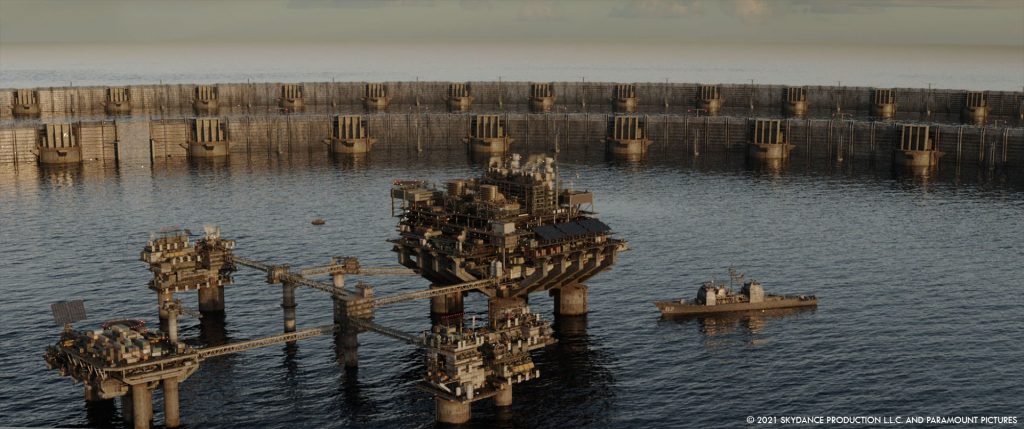
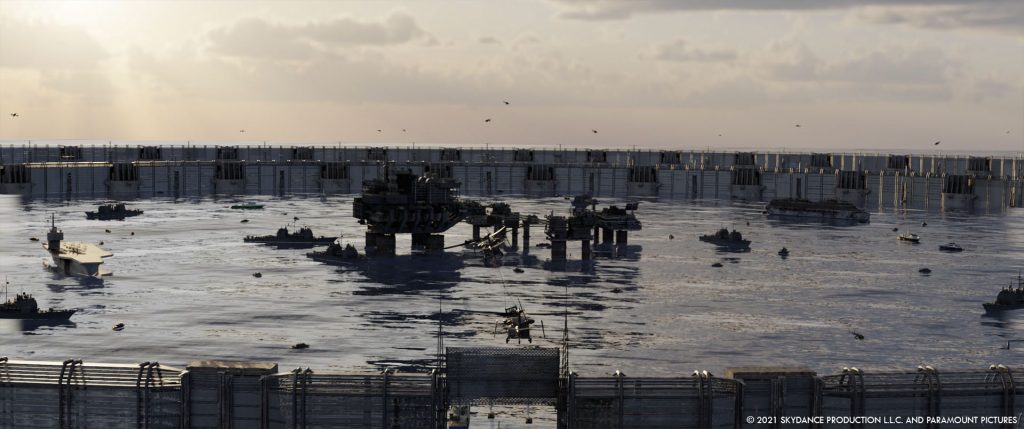
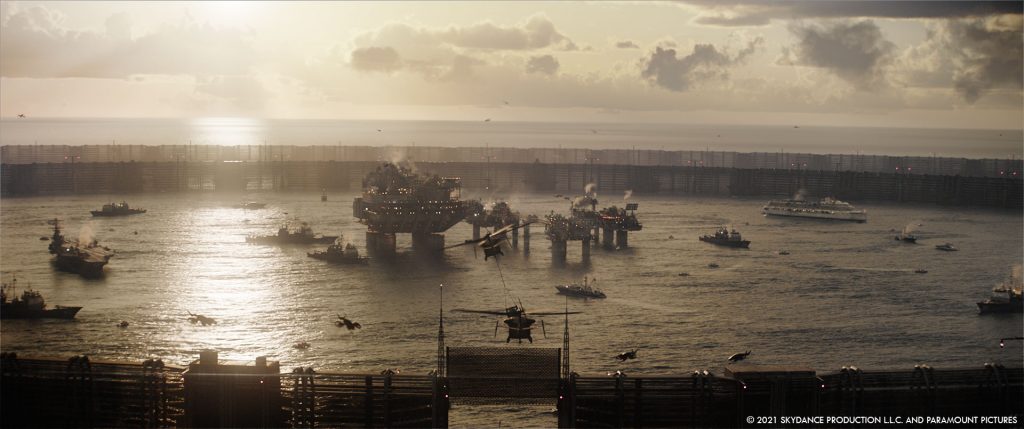
How did you populate the oil rig with crowds and vehicles?
Carmelo Leggiero // Our Moted and Crowds team were in charge of dressing the scene to ensure it always felt like there was activity everywhere you looked. We used our mocap facilities to capture motion for civilians and soldiers, which they deployed into the layout.
Drones were a mix of keyframe animation (for more bespoke action) and our crowd tool Massive, which uses an AI approach. The agents have fuzzy logic rules that steer the brain for navigation, avoidance, terrain adaptation, etc. They can also be more intelligent than that. For example, if a potential target is ‘seen’ but isn’t quite within range, an agent will navigate closer to attack.
As well as driving the agent through space, fuzzy logic rules also take care of secondary motion, such as offsetting rotor orientation or tracking weapons systems. It was always great to see the results of the Crowd team’s work. Seeing an empty layout become a vibrant and busy scene made us go, “OK… we’ve got ourselves a BATTLE!”
We also have Helicopters that fly, land, take-off and crash, and that was all keyframed.
Can you tell us more about the ocean creation?
Sheldon Stopsack // Having worked on a water-centric show in the past, I knew what we were up against. The trouble with oceans is that they are always more than just water planes that extend to the horizon. We made the ocean behave organically by respecting the rules of physics and its interactions with surrounding structures, . We also made it responsive to sea mine explosions and large chunks of debris crashing into it. Boris Bruchhaus was one of the key players supporting our water needs. In recent years, there has been a good chunk of development work at Weta to strengthen our ability to deal with water-based effects. We utilised this expertise and put an infrastructure in place that allowed us to deal with the broad-range requirements. One area that deserves to be singled out is our efforts around ‘thin film’, a technique that deals with thin layers of water running across the surface of a creature when it emerges from water. A number of hero shots showed hundreds of creatures brawling in the water, waiting for Muri to land. The high frame rate meant we had to run these costly simulations at a subframe rate. The results we saw were exciting, and I am keen to see more of this technique used in the future.
How did you handle the various destructions of Deepswell?
Sheldon Stopsack // As mentioned before, we needed to build Deepswell in a smart way. We knew we couldn’t just build it at a low resolution and simply hope that we’d never get close enough to see it. One aspect of that was the requirement to impose structural damage. As our models and layout team was working on achieving the required level of detail, Yann Moalic, our FX Supervisor, engaged closely with the asset team to ensure our FX needs were meet. Cross-department communication was key along the way.
Can you explain in detail about the beautiful shot in slow-motion with Chris Pratt falling in the void?
Sheldon Stopsack // I believe you are referring to the wide profile shot showing Dan, Muri and the female white spike falling into a pit of relentless male white spikes, all waiting for their feast to drop while the world collapses around them in slow motion…we jokingly called this the “Sistine Chapel shot”. It encompassed every aspect that we had worked towards, and we almost treated the shot like a painting. Our Comp Lead Emily Vaillancourt worked closely with the team to carefully piece together every aspect we put into this sequence and what they were meant to stand for. I should also give credit to Jamie Price, who set the foundation of this shot during previs. It just felt like an appropriate way to leave Deepswell and travel back in time.
How did you create the massive explosion in the glacier?
Sheldon Stopsack // This was more an aesthetic question than a technical one. While combustion effects are always difficult for various reasons, I had faith in our team to deliver. The trick was to match the SFX footage that was captured during filming in Iceland. SFX had set up some beautiful explosions that were filmed on a rather overcast day. The warmth and energy of the explosion blended beautifully into the cool, diffused atmosphere of the Icelandic glacier setting. It was the combination of those two things that we wanted to honour. The positive by-product of that was that we could hold onto some of the practical SFX and combine them with our work. In my mind, it was a perfect example where SFX and VFX complement each other.
Which shot or sequence was the most challenging?
Sheldon Stopsack // It is almost impossible to single out one shot or sequence as the most challenging. The spectrum was incredibly broad, so we had to rely on each other as a team and on Weta’s expertise. But one shot will remain in my memory. It was part of our first turnover and we didn’t deliver it until late in the game. It wasn’t an obvious candidate to be considered particularly difficult, it just happened to be a bit of a “turkey”. It came together nicely in the end but too a lot longer than usual. I shall not disclose which shot it was—sorry!
Is there something specific that gives you some really short nights?
Sheldon Stopsack // My kids sometimes.
A big thanks for your time.
WANT TO KNOW MORE?
Weta Digital: Dedicated page about The Tomorrow War on Weta Digital website.
Amazon Prime: You can now watch The Tomorrow War on Amazon Prime Video.
© Vincent Frei – The Art of VFX – 2021




